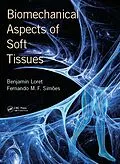Biomechanics applies the laws and techniques of mechanics in the study of biological systems and related phenomena. Biomechanics uses mathematical and computational tools such as model construction of musclo-skeletal system, body fluid circulation, to aid medical diagnosis, therapeutics and surgery planning, designing of prostheses and implants or in tissue engineering. Present book targets specific topics pertaining to the biomechanics of soft tissues. Subjects addressed includes solids and multi-species mixtures as open systems: a continuum mechanics perspective; electro-chemo-mechanical couplings: tissues with a fixed electric charge and growth of biological tissues.
Autorentext
Benjamin Loret is professor of mechanics and civil engineering at the University of Grenoble, France. His research addresses the constitutive responses of engineering and biological materials to static and dynamic loadings. He has especially focused on the couplings of thermal, hydraulical, electrical, chemical and mechanical natures that are ubiquitous in fluid saturated porous media. Applications target innovative energy production systems and biomechanics of soft tissues.
Fernando. M.F. Simões was born on July 23rd, 1964, in Lisboa, Portugal. He has received is Ph.D. degree in civil engineering from the Instituto Superior Técnico of the Technical University of Lisboa, Portugal, in 1997. Presently, he is Assistant Professor at the Department of Civil Engineering, Architecture and GeoResources (University of Lisbon). His research interests include structural mechanics and biomechanics.
Inhalt
1.Biomechanical topics in soft tissues. Introduction. Diffusion, convection, osmosis: towards wearable artificial kidneys. Issues in drug delivery. Macroscopic models of tissues, interstitium and membranes. Energy couplings, passive and active transports. More general direct and reverse couplings. Tissue engineering re-directed to tumor tissue exploration. From mechanics to biomechanics. Mechanisms of injury of the knee, fracture mechanics. Water and solid constituents of soft tissues. 2. I Solids and multi-species mixtures as open systems :a continuum mechanics perspective. 3. Elements of continuum mechanics. Algebraic relations and algebraic operators. Characteristic polynomial, eigenvalues and eigenvectors. A few useful tensorial relations. The differential operators of continuum mechanics. Measures of strain. Transports between reference and current configurations. Time derivatives and Reynolds theorems. Work-conjugate stress-strain pairs. Small upon large. Kinematical constraints and reaction stresses. Invariance, objectivity, isotropy. Exercises on Chapter. 4. Thermodynamic properties of fluids. Basic thermodynamic definitions. Phase change. Thermodynamic functions of fluids. Laplace's law of mechanical equilibrium at the interface between two immiscible fluids. Henry's law and Raoult's law of chemicalequilibrium between a liquid and a gas. Composition of fluids in plasma, interstitium, cell. 5. Multi-species mixtures as thermodynamically open systems. The thermodynamically open system. Chemomechanical behavior and growth of soft tissues. General form of balance equations. Balance of mass. Balance of momentum. Balance of energy. Balance of entropy and Clausius-Duhem inequality. Dissipation mechanisms. General constitutive principles. Appendices of Chapter. 6. Anisotropic and conewise elasticity. Hypoelasticity, elasticity and hyperelasticity. Anisotropic linear elasticity. Spectral analysis of the elastic matrix. Fiber-reinforced materials: extension-contraction response. Exercises on Chapter. 7. Hyperelasticity, a purely mechanical point of view. Restrictions to the strain energy function. Properties of constitutive functions and partial differential equations. Total potential energy. Isotropic hyperelasticity. Anisotropic hyperelasticity and Fung's strain energy. Elastic potentials with the elastic-growth multiplicative decomposition. Return to the conewise response in presence of fibers. Elasticity and workless constitutive stress. Use of right and left Cauchy-Green tensors. Exercises on Chapter. 8. Poroelasticity with a single porosity. Geometrical, kinematical and mechanical descriptors. Elements of mixture theory: the level/scale of the species. Anisotropic poroelasticity: a composite material format. Anisotropic poroelasticity: drained and undrained properties. Unconfined compression of a poroelastic cylinder. 9. Viscoelasticity and poro-viscoelasticity. Viscoelasticity, poroelasticity and poro-viscoelasticity. Intrinsic time dependent behavior of collagen fibrils. Complex modulus. Relaxation spectrum. The quasi-linear viscoelasticity QLV model of Fung. Overall viscoelastic properties: ECM and a contractile cell. An electrical analogy applied to the corneal endothelium. Fluid infusion in a viscoelastic polymer gel. Confined compression of a viscoelastic polymer gel. Compression of a poroelastic layer: displacement control. Visco-hyperelasticity and other memory effects. Exercises on Chapter. 10. Thermoelasticity and thermo-poroelasticity. Thermomechanical properties of elastic solids. Thermoelastic heat, stored energy and dissipated energy. Anisotropic thermo-poroelasticity : mechanics, transport, energy. Generalized compatibility conditions for the stress. Heating a thermo-poroelastic medium. Exercises on Chapter. 11. Transfers of mass, momentum and energy. Summary of balance equations. Intercompartment mass transfers. Momentum supply in a poroelastic context. The bioheat equation. Mass and energy transfers between a liquid and a solid. A porous medium with two porosities and three temperatures. A porous medium with a single porosity and two temperatures. Interfacial transfer coefficients and specific surface areas. The coefficients of transfer: two scale derivation. 12. Waves in thermoelastic solids and saturated porous media. Basic definitions. Waves in elastic solids. Acceleration waves in thermoelastic solids. Acceleration waves and acoustic waves in fluids. Acceleration waves in saturated porous media. Propagation of acceleration waves in saturated porous media. Plane motions and Helmholtz potentials in poroelasticity. Silent poroelastic boundaries. Surface waves in a saturated porous half-plane. First order waves in saturated porous media. Exercises on Chapter. 13. II Electro-chemomechanical couplings in tissues with a fixed electrical charge. 14. Directional averaging for fiber-reinforced tissues. Directional analysis. A simple fiber model for the collagen network. Directional models of tissues. The mechanical response of individual fibers. Fabric tensors. Spatial homogenization over cells and ECM. 15. Electro-chemomechanical couplings. Chemomechanical couplings in engineering and biology. Molar volumes, electrostriction. Electrokinetic processes. Nanoscopic aspects. Hydration, hydrolysis, complexation and solubility. Some basic notions of electrostatics. Semi-permeable membrane and osmotic effect. Reverse or Inverse osmosis. Electrical repulsion and electrical shielding. The pore composition in materials with fixed charge. The heart muscle and cell electrophysiology. Reverse couplings. A partially coupled chemo-poroelastic model. Exercises on Chapter. 16. Chemomechanical couplings in articular cartilages. Overview. Histological aspects of articular cartilages. Pathologies, osteoarthritis, rheumatoid arthritis. A brief review of modeling aspects. Interpretation of laboratory experiments. Partition of the tissue into phases. The constitutive structure: deformation, mass transfer, diffusion. Chemoelastic energy of the tissue. Features of the constitutive framework. Remarks on constitutive frameworks and constraints. Exercises on Chapter. 17. Passive transport in the inter…
